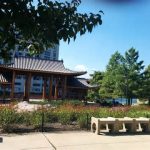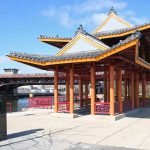A Walk in the Park
On a sunny afternoon in the heart of Chicago, children speed around on bicycles as parents relax under a small, Chinese-style pagoda. Near the pagoda stands an inconspicuous granite bust and inscription dedicated to the park’s namesake. The public site I chose to visit was the Ping Tom Memorial Park situated in Chicago’s Chinatown.
Named in honor of one of Chinatown’s most important civic leaders Ping Tom, the park was constructed and opened in the fall of 1999. A successful businessman and board member of multiple civic organizations in the Chinese community, Tom worked tirelessly to improve the lives of Chinatown’s residents through expansion and commercial development. Though the site itself does not include historical evidence, the use of a singular bust and inscription serves as subtle yet meaningful tools for public education. I picked this site because it acts not only as a valuable location for today’s bustling Chinese community, it also represents the Asian-American desire to push for a space of its own in a land that has historically oppressed them.
For decades, Chicago’s Chinatown has served as a cultural hub of Chinese and other Asian American communities. As Gary Y. Okihiro’s text American History Unbound describes, Chinatown in its earliest form began in the 1880’s (320). Indicative of the Asian-American narrative as a whole, the early residents of Chinatown encountered no small number of racist and exclusionary incidents. In the early 1900’s, gentrification and rising rents caused the Chinese community to uproot itself from Clark Street and relocate to Chicago’s South Side. In 1926, Rosehill Cemetery evicted the Chinese, forcing their families to exhume the remains of 412 individuals and ship them back to China.
In his paper titled “Chinatown: Conflicting Interests, Contested Terrain,” Professor Scott Wong of Williams College adds that the commonly-held imagery surrounding Chinatowns across the nation has been largely shaped by uninformed third-party individuals and the discourse over racist and exclusionary policies (3). In his paper, Wong searches for a deeper understanding of these communities and relays a description of Chicago’s own Chinatown. The individual, a translator living in Chicago in 1984, writes that residents “traced their origins mostly to Canton or neighboring counties. Many were descended from laborers. They didn’t trust outsiders” (13). Given the history of exclusion of not only Chicago Chinese but Chinese across the nation, this wariness of outsiders is understandable. Nevertheless, individuals like Ping Tom sought to bridge gaps between the Chinese community and the rest of Chicago through diplomacy and social lobbying.
In the context of the larger Asian-American history, Ping Tom Memorial Park stands as a symbol of success in the Asian-American struggle to shape their own lives and communities. In 1992, seventy-five percent of Chinatown’s leaders felt that “a lack of an open space in the Chinatown area” was one of the community’s most pressing issues. Through the leadership of people like Ping Tom, the Chinese American community was able to organize and fight to construct a public park for the residents. For the majority of Asian-American history, it has not been easy for immigrant groups to lobby and impact social policy. Policies created by white Americans have long dictated the lives of Asian communities. But success stories like the Ping Tom Memorial Park serve to challenge this narrative and pave the way to a new one for the future. It represents that Chinese Americans can take control of their own lives and in doing so, carve out a new identity for themselves and generations of Asian-Americans to come.
Okihiro, Gary Y. American History Unbound: Asians and Pacific Islanders. Oakland: U of California, 2015. Print.
Wong, K. Scott. “Chinatown: Conflicting Images, Contested Terrain.”Melus 20.1 (1995): 3-15.


Stephen Sit (71) writes, “. . .excellent paper and well said about the struggle we have gone through to gain recognition from mainstream folks in Chicago.”
Cheung Ping Kam (71, HK), “Adam’s essay prompted me to search for this Ping Tom. Died in 1995 at 60. Chinese name was 譚繼平. Pity that probably for obvious reasons, a Tam became a Tom.
It seems Chinese names are so often Americanised or Christianised but American Japanese or Korean not so. Interesting but why?”
Pius Lee (71, CA), “Hans Schmidt or Sam ting…wats real name 🙂
A man was walking through Chinatown when he noticed a sign reading: “Hans Schmidt’s Chinese Laundry.” Being of a curious nature, he entered and was greeted by an old Oriental man who identified himself as Hans Schmidt.
“How come you have a name like that?” inquired the stranger.
“Is simple,” says the old Oriental man.
“Many, many year ago when come to this country, stand in immigration line behind a big German guy. Immigration lady look at him and go, “What your name?”
He say, “Hans Schmidt.”
Then she look at me and go, ‘What your name?'”
“I say, Sam Ting.” :p
For those who don’t understand this (Sam Ting=same thing)